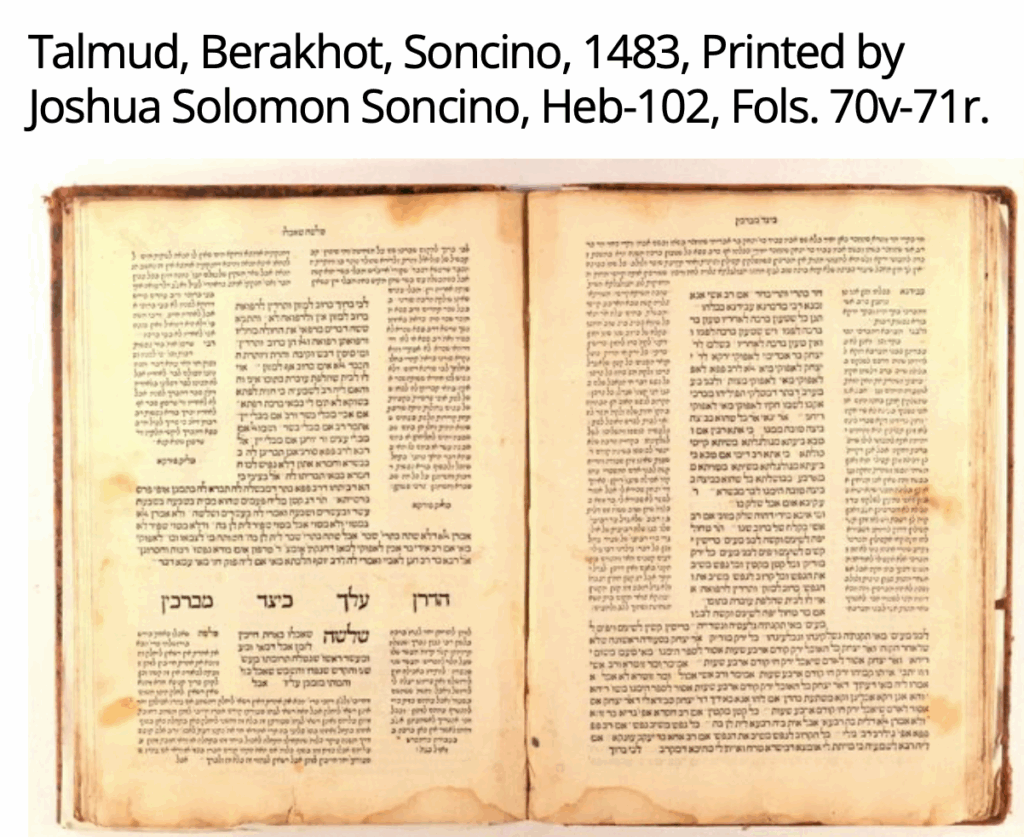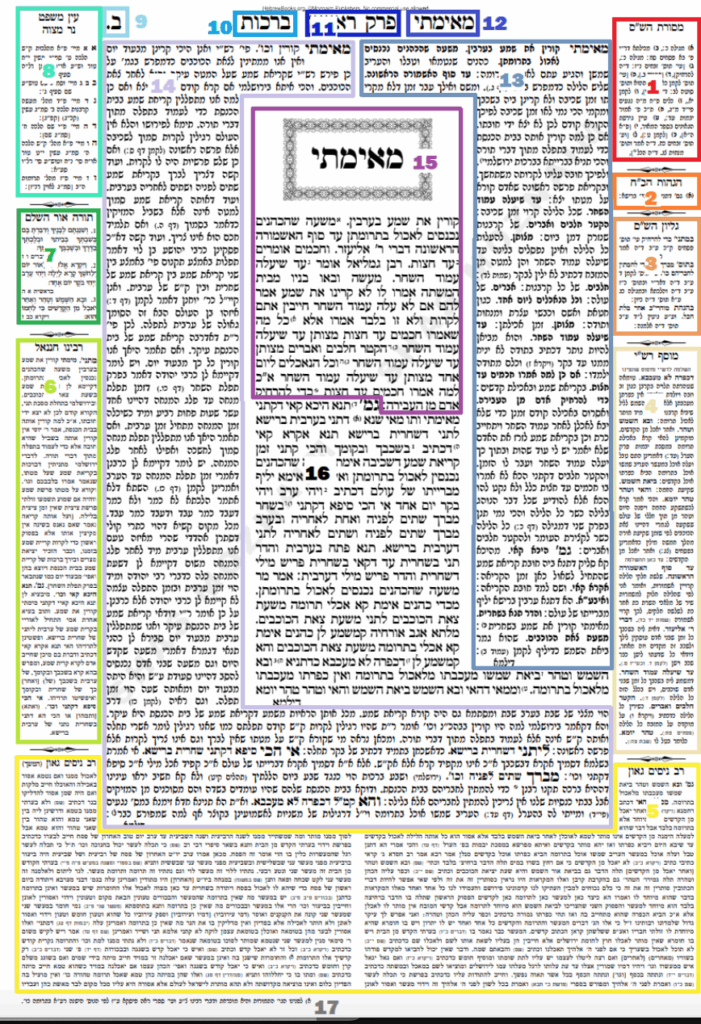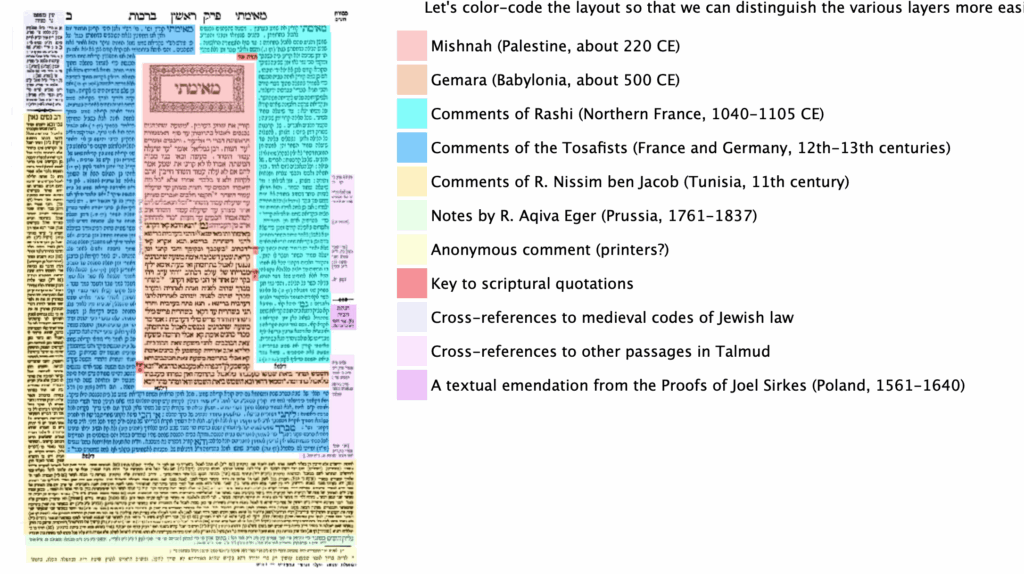- Visual takeaways from the Talmud Page layout:
- Multi-dimensional Perspectives
- Multi-Time dimensions erasing time barriers “present discussions”
- Multi-geographic dimensions
- Seeing Patterns – using Photoshop layering
- Agam’s concept of theater presents multiple simultaneous scenes



Visually, what do we learn from the Talmud Page ?
Where the Torah itself and its unchanging text reflect the ancient agricultural milieu, the transition to a more urban and manual trade and commerce life is reflected in the Talmud with its dialogues on ritual life and lore. While honoring the Torah text as “written law”, the Talmud does place emphasis on the more expansive and flexible “Oral Law”
| Torah Text | A Typical Talmud Page Layout |
There is actually an expression for the page layout of the Talmud “Tzurat ha-daf”. As will be explained, in our context the visual gleanings of the “Tzurat ha-daf” are quite impressive. Among the Visual take aways from the Talmud Page layout:
- Pattern recognition
- Multi-dimensional Perspectives
- Multi-Time dimensions erasing time barriers “present discussions”
- Multi-geographic dimensions
- Seeing Patterns – using photoshop layering
- Agam’s concept of theater presenting multiple simultaneous scenes
Pattern Recognition – A Visual Eye Chart of Multi-dimensional Perspectives
“Tzurat ha-daf” as illustrated in the left box below is a result of a printer’s iniative in the 1400’s. With the introduction of the printing press, it was possible to format a page with columns, indexes and other references. The multi-color image in the right box below is a color coded depiction of another Talmud page with colors used to point out geographic sections of a printed page.
Table 3. Images of talmudic pages
Students of the Talmud since the invention of print technology have benefited from the Tzurat ha-daf as a visual pattern that has the multiple sources in specific page locations. They become accustomed to reading the page to know what is available to them in the pursuits. While editions of the two variations of the Talmud, Babylonian and the Yerushalmi might show differences, the each have their own constant “Tzurat ha-daf”
Yoel Finkelman provides a brief functional and highly informative guided tour, which I have juxtaposed with the color code. He suggests: the dialogue on the Talmud page occurs over time and space.
| A Guided Tour | Color Coded Model |
| “Tzurat ha-daf exemplifies the tradition of discursive and layered reading. The Mishna is placed in the center, marking it as most authoritative, while the Gemara follows it in the center, marking it as an authoritative commentary. Both are in the more formal square script. Rashi and Tosafot, in a less formal semi-cursive script on the side, mark them as chronologically later layers, less authoritative, but visually revolving around the Gemara. Placing Rashi and Tosafot on opposite sides visually matches the regular and consistent disagreements between the commentaries, both about specific readings and about their reading strategies and methods. Having these texts and commentaries on the same page allow not only for multiple texts and commentaries, but represent a dialogue that is occurring over real, chronological time and over conceptual, layered time. Yoel Finkelman ;From Bomberg to the Beit Midrash: A Cultural and Material History of Talmudic Page Layout Tradition Magazine 551 |
Multi-Time dimensions erasing time barriers as if “present discussions”
“The text on the page of the Gemara spans over 1500 years of Jewish history. It includes the entirety of Rabbinic literature from the Mishna in the second century through the Gemara in the seventh, through Rashi and the Tosafists in the high Middle Ages, including the contemporary contributions of staff in the printshop adding footnotes and references.” (Yoel Finkelman ;From Bomberg to the Beit Midrash: A Cultural and Material History of Talmudic Page Layout Tradition Magazine 551)
Multi-geographic dimensions
“The geographic spread of the voices written or referenced in the page. The Mishna comes from the Land of Israel, while the Talmud took shape in today’s Iraq. Rashi and the Tosafists were active in northern Europe, while Maimonides, whose commentary on the Mishna is found after the Talmud, wrote in northern Africa. The Rosh, whose commentary is also found toward the back of the book, by virtue of immigrations during his life, bridges the communities of Germany, France, and Spain. The book itself was printed in Italy. Every geographical region of Rabbinic significance appears in the book.38 Through the act of study, the student can experience him or herself not only as knowledgeable in texts, but as part of a transhistorical and transnational Jewish people and as a participant in a transhistorical and transnational conversation” (Yoel Finkelman ;From Bomberg to the Beit Midrash: A Cultural and Material History of Talmudic Page Layout Tradition Magazine 551)
Seeing and Visualing Patterns
The color coded model of Tzurat ha-daf is informative but academic. Something amazing happened when I opened an image of a Talmud page in Adobe’s Photoshop, and added a layer upon which I roughly traced sections in different colors. This created a more striking visual image.
Similarities to Modern Art ?
| A Ya’akov Agam Image | The Color overlay Pattern over a talmud Page | The Color Overlay Pattern without talmud Page showing |
Agam’s concept of theater presenting multiple simultaneous scenes
1959. Initial research in the multistage theater.
| Agam’s theater concept became a reality in 1965 during a theater festival in Dijon, France. The performed play (written by Michel Parent) told a fictionalized story about the pilot who dropped the atomic bomb on Hiroshima. Amazingly, the audience was able to hear and understand everything despite multiple stages presenting different aspects of the pilot’s life at the same time. |
Leave a Reply
You must be logged in to post a comment.